Inverurie WwTW (2018)
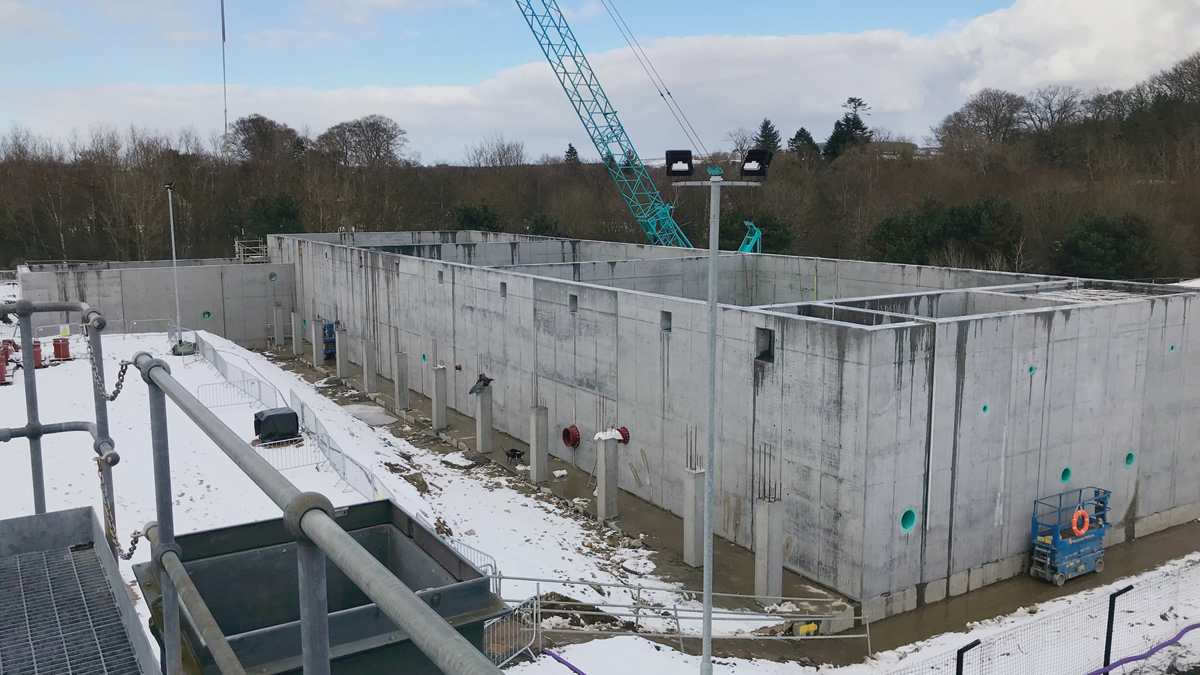
Completed Nereda tank - Courtesy of Scottish Water
Inverurie WwTW is located in Aberdeenshire in the north-east of Scotland and provides sewage treatment for Inverurie and the surrounding area including Blackburn, Kintore and Port Elphinstone. It currently serves a population of 28,000, but Inverurie is one of the most rapidly growing towns in terms of population in the UK, with an estimated population forecast of 33,000 in the coming years. The existing works is split into two sites; Inverurie Old Works and Inverurie New Works. The two sites are split by the Aberdeen-Inverness railway line and are bordered by the River Don to the West and River Urie to the East. The Old Works was first commissioned in the early 1970s and refurbished in 1997 with a new inlet works being constructed. The New Works was constructed as an extension in 2001 to ensure compliance with discharge consents. The project is being delivered by ESD; a Galliford Try, MWH Treatment and Binnies Joint Venture formed in order to manage, design and deliver Scottish Water’s Q&SIV Non Infrastructure Programme.
Existing works and drivers
The current treatment at Inverurie WwTW (Old Works) consists of storm separation screening and grit removal, followed by settlement in 4 (No.) primary settlement tanks. Settled sewage is then divided into two streams, half being treated at the Old Works and half is pumped to Inverurie New Works for treatment. The main drivers for the Inverurie WwTW Upgrade Project are:
- Meeting requirements of the Urban Wastewater Treatment Directive.
- Capital maintenance.
The aim of the Urban Wastewater Treatment Directive driver is to ensure that Inverurie WwTW meets the future discharge licence requirement of 2mg/l total phosphorus and iron. The revised licence also requires a tightening of the ammoniacal nitrogen requirement to 20mg/l from the current 40mg/l.
The aim of the capital maintenance driver is to refurbish, renew or make safe elements of the works so that performance, reliability and health and safety are improved.
It is proposed to continue with preliminary treatment and storm separation at the Old Works but abandon the primary and secondary treatment facilities. All flows will be transferred to the New Works for primary and secondary treatment and the New Works will be upgraded to treat the increased volume with the construction of a new Nereda® Wastewater Treatment Tank and process.
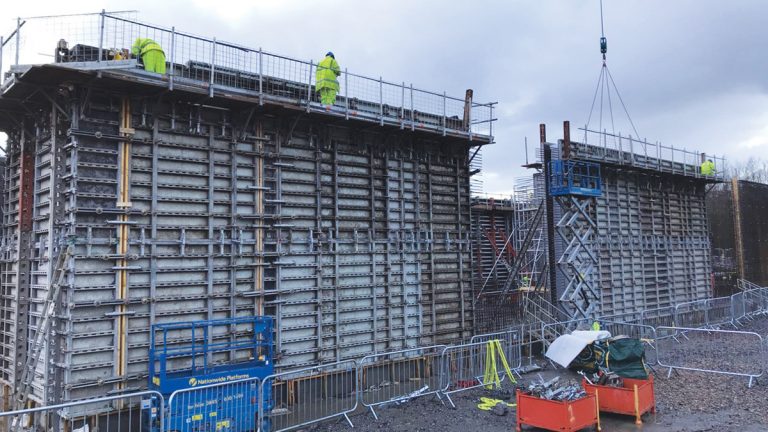
Nereda tank external shuttering – Courtesy of Scottish Water
Design
The design of the project is being undertaken by Stantec Treatment (one of ESD JV’s parent companies). The project has made extensive use of BIM. A 3D laser scan of the Old Works and Keithhall Road was undertaken by the design team at the beginning of the project. Data from this has then been used in the creation of a BIM360 Glue model.
Various subcontractors and suppliers have also fed into the model; EPS Water for the design of the Nereda system, Coffey Construction Ltd for the design of the TPS shaft, and Eliquo Hydrok Ltd for the integration of both the CSO storm screen and CWF flushing systems. The project team has also made use of BIM360 Field for the completion of daily diaries, checklists and general recording purposes.
Process
When the project is completed the process at the Old Works will be abandoned. The incoming influent to the Old Works from the Port Elphinstone, Osprey and Kintore Mains will be transferred to the inlet at the New Works via the new transfer pumping station. It will then pass through the new packaged inlet works and into the influent buffer tank of the Nereda wastewater treatment technology developed by RHDHV.
The influent will then be treated within one of the three reactors of the Nereda system. Biomass in Nereda develops as fast settling aerobic granular sludge and therefore Nereda does not require a separate decant phase like conventional sequential batch reactor’s, therefore shortening the process. The whole biological treatment process take place simultaneously in the granules. Due to the characteristics of aerobic granular biomass, Nereda technology uses an optimised SBR cycle which allows for a simultaneous influent feed and effluent discharge.
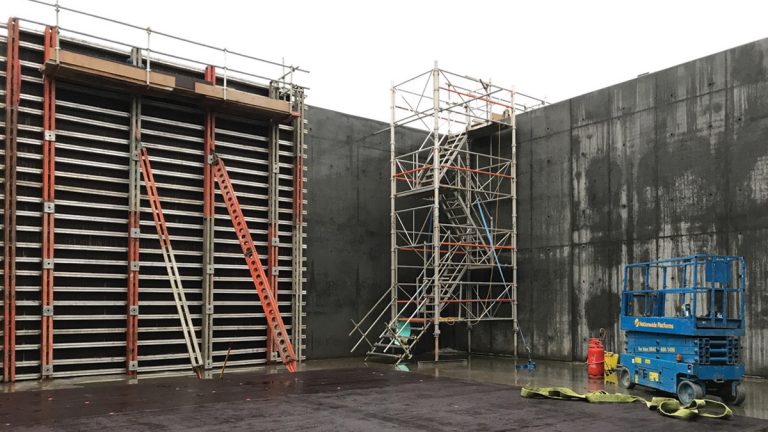
Nereda tank internal shuttering and completed wall – Courtesy of Scottish Water
Technical description
New Works: The most significant area of the project to be undertaken at the New Works is the construction of the tank which is to house the Nereda wastewater treatment system. The tank consists of three reactor cells (18m x 16m x 7m), an influent buffer tank (16m x 6.5m x 5.3m), 2 (No.) sludge buffer tanks (6.5m x 4.2m x 7m) and a final effluent tank (2m x 4.2m x 7m). All external walls and the walls separating the Nereda Reactors are 600mm thick while the walls separating the sludge buffer tanks and the final effluent tank are 500mm thick. The Nereda tank structure will be constructed with reinforced concrete. All civils work, including underground pipework associated with the Nereda tank, will be undertaken by Coffey Construction Ltd.
Once the tank is completed, EPS will begin the mechanical and electrical installation associated with the Nereda system. EPS are the sole licensee holder for the installation of Nereda in the UK. As part of their scope, EPS will also supply and install all access steelwork to the Nereda tank.
Another significant part of the project is the new inlet works that requires to be installed. This will be procured as a DfMA packaged plant through MEPS (a Stantec Treatment/EPS JV). MEPS will procure the screens through Huber Technology and the inlet works will be constructed in factory conditions before being shipped to site. When on site, the inlet works will be installed on a reinforced concrete slab which is to be constructed by Coffey Construction Ltd.
Coffey Construction Ltd are also undertaking the following civils work at the New Works:
- Base slabs for MCC kiosk, crane pads, blower units, wash water booster.
- 500mm diameter DI pipeline from final effluent tank to existing SEPA sampling chamber.
- All ducting and drawpits.
- High level drainage for new Nereda plant.
- Installation of wash water pipeline, sludge return pipeline and return liquor pipeline.
- Installation of sheet pile wall to provide compensatory flood storage volume.
The MCCs on both sides of the works are to be supplied and installed by MCS Control Systems and housed in kiosks supplied and installed by Quinshield. An (as yet) unconfirmed electrical installation contractor will then install a site-wide profibus system and all instrumentation required to power the works.
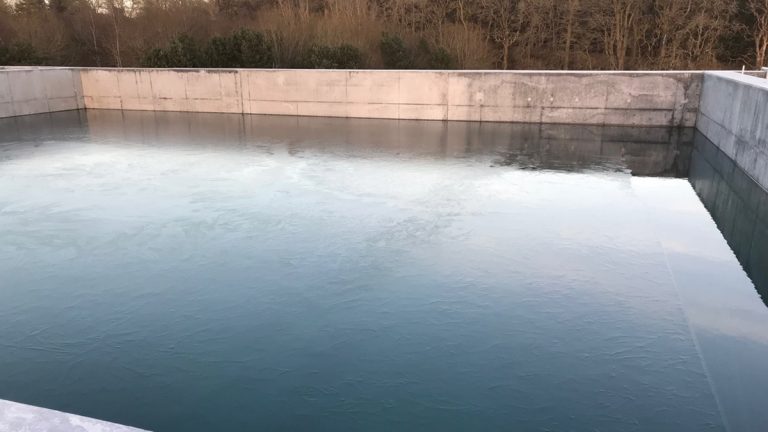
Hydrostatic testing of Nereda tank – Courtesy of Scottish Water
Old Works: The main scope within the Old Works is the construction of a new transfer pumping station (TPS) from an existing primary settlement tank. This new TPS will gather flows from the new 1050mm gravity sewer from Inverurie as well as Port Elphinstone, Osprey and Kintore/Blackburn Pumping Mains. All civils work for the TPS will be undertaken by Coffey Construction Ltd and once this is complete the mechanical installation will commence.
Eliquo Hydrok Ltd will supply and install a CSO storm screen within the TPS and an (as yet) unconfirmed mechanical installation subcontractor will install the three transfer pumps (supplied by Hidrostal) as well as the three storm pumps and the storm sump pump (supplied by Xylem Water Solutions). Industrial Penstocks will also install two electrically actuated 1,000 x 1,000mm isolation penstocks within the TPS.
A transfer rising main will then be installed to connect the TPS to the new inlet works. This work will require Keithhall Road to be closed for three weeks while the middle section of the pipeline is installed.
The other three existing PSTs will be converted into storm tanks. This work will also be completed by Coffey Construction Ltd. The tank walls are to be raised above the flood level. Eliquo Hydrok Ltd will then supply and install a CWF flushing system to each storm tanks. The mechanical installation subcontractor will then install all pipework connecting the TPS and the storm tanks. Industrial Penstocks will supply and install a 400 x 400mm drain penstock in each storm tank as well as one within the storm return collection chamber.
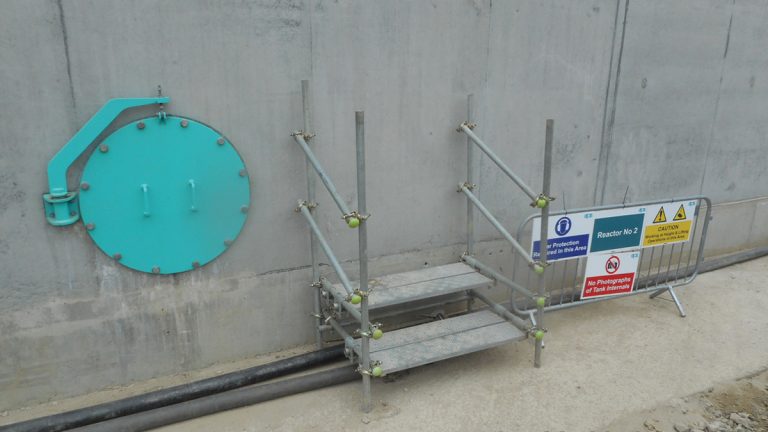
Low level man access to reactors to reduce working at height – Courtesy of Scottish Water
Coffey Construction Ltd will also install a new pipeline connecting two existing outfalls at the Old Works. This will negate a requirement for a new outfall which was initially proposed and therefore working within the river.
There is also a requirement in the project to upgrade the existing Port Elphinstone Pumping Station. The detail of this scope is being assessed by Scottish Water at present.
Inverurie WwTW: Table of designers, contractors and suppliers
- Principal contractor/designer: ESD JV
- Nereda technology process designer/patent holder: Royal Haskoning DHV Ltd
- Civil construction: Coffey Construction Ltd
- M&E installation/commissioning of Nereda plant: EPS Water
- Inlet works: MEPS
- MCCs: MCS Control Systems Ltd
- Kiosks: Quinshield Ltd
- Penstocks: Industrial Penstocks Ltd
- CSO storm screen & CWF storm tank flushing system: Eliquo Hydrok Ltd
- Mechanical installation: A&L Mechanical Installation
- Steelwork Fabrications: AJ Engineering & Construction Services Ltd
- Transfer pumps: Hidrostal Ltd
- Storm/storm sump pumps: Xylem Water Solutions
Progress to date (30 April 2018)
New Works: Site establishment and civils construction began in August 2017 undertaken by Coffey Construction Ltd. The main element at the New Works was the construction of the reinforced concrete Nereda Tank. The base slab for the tank is 600mm thick. In the overall construction of the tank, 2,000m3 of concrete was used and 307t of steel reinforcement. Concrete pours ranged between 20m3 and 263m3. A fair faced finish was achieved by relining the shutters with 9mm super slim plywood. Due to the quality of the finish, no bag rubbing was required.
The final concrete pour for the Nereda structure was on the 22 February 2018. Since then, the structure has passed hydrostatic testing and all minor cracks have autogenously healed. EPS arrived on site in March 2018 to begin the installation of the Nereda system. To date, all internal steelwork and pipework has been installed in Reactors 1, 2 and 3. Internal work within Sludge Buffer Tanks 1 and 2 has also been completed.
Transfer Main: After the completion of the civil work associated with the Nereda tank, Coffey Construction Ltd began the installation of the transfer rising main which will transfer the flows from the TPS at the Old Works to the inlet works at the New Works. This operation came with many challenges, including working on a public highway and working underneath a railway bridge.
The rising main consists of a 400mm diameter DI pipe. The main is being installed in three sections. The middle section was 200m in length and was installed on Keithhall Road. To carry out these works, a full road closure was required. These works were planned for the Easter holidays to minimise disruption to the local school.
The West section has also been installed, this section runs from Keithhall Road to the new Nereda inlet works. The East section is currently being installed to take the rising main into the new transfer pumping station.
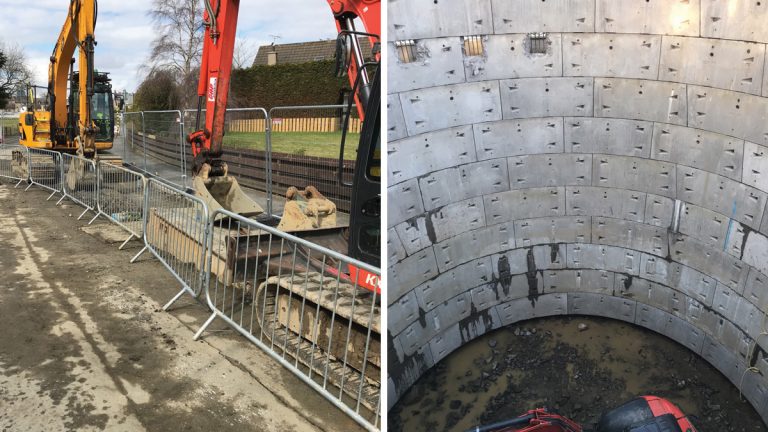
(left) Installation of rising main and (right) construction of TPS shaft – Courtesy of Scottish Water
Old Works: Construction of the new TPS began in December 2017. The pumping station is replacing an existing PST. The PST slab was broken out and excavation began to allow for the first shaft ring to be installed. The first ring installed was ‘ring 6’. The shaft rings were then built up to ring 1 and dowelled into the existing PST concrete walls as a means of anti-flotation. Once the top six rings were installed and anchored into the existing PST wall, the gap behind the shaft segments and the PST wall was filled with mass concrete backfill. This allowed for the base of the shaft to be excavated and the final four rings to be hung. Rock anchors were installed at the base of the slab as an additional anti-flotation measure and the 1,000mm deep RC slab was poured.
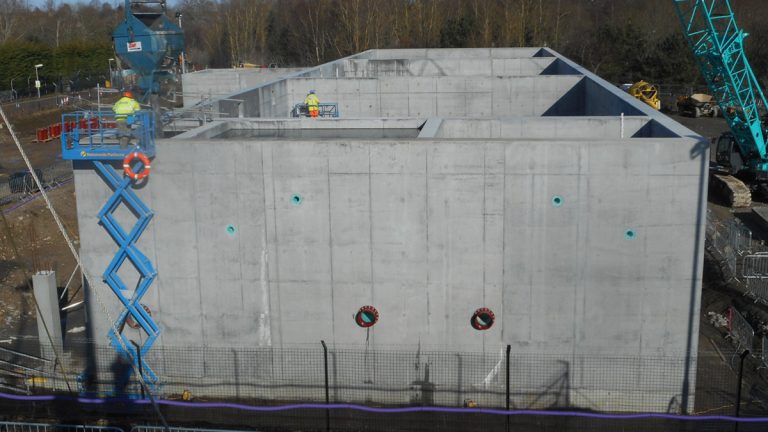
Nereda reactors – construction in progress – Courtesy of Scottish Water
Conclusion
Completion of all construction work is anticipated in June 2019. The last activity to be undertaken will be a return visit from the subcontractors to complete the conversion of 2 (No.) PSTs to storm tanks. This is due to the requirement that the process at the Old Works is to remain operational until the turn of flows to Nereda, which is programmed to be operational in April 2019. After a period of commissioning and training, approval and acceptance by Scottish Water is anticipated in January 2020.











